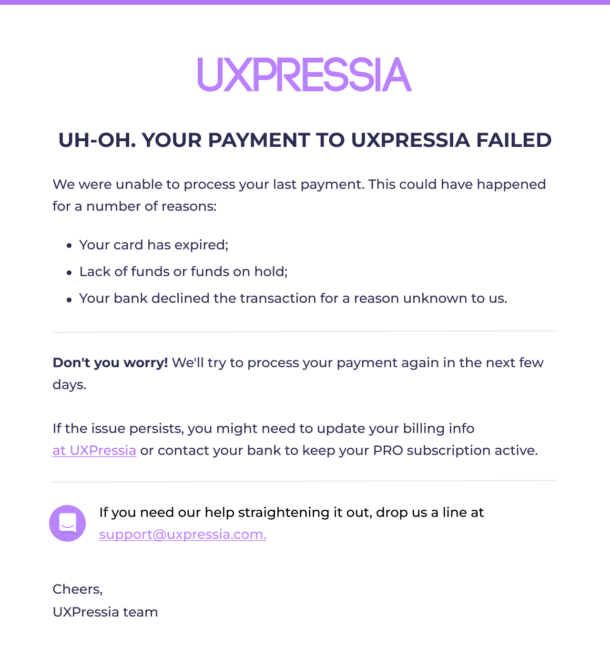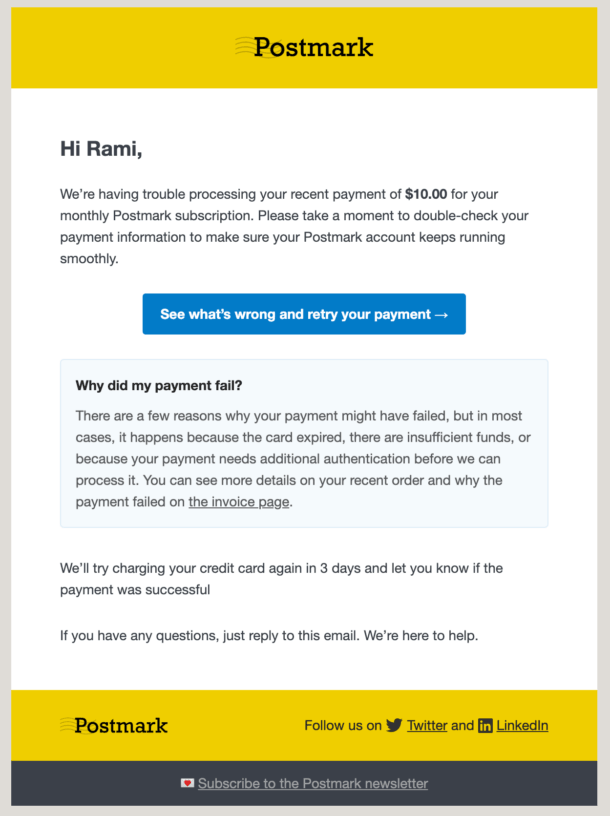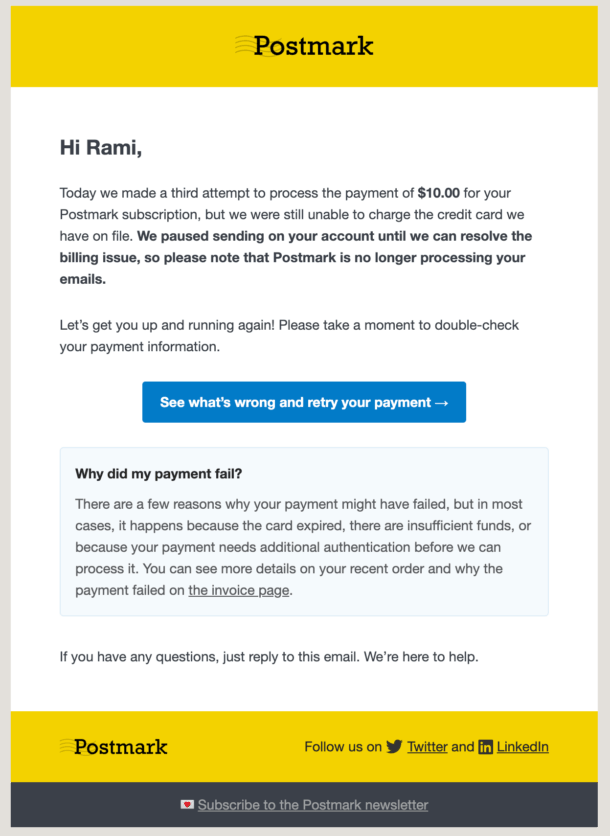Here's a sneaky but all-too-common phenomenon all subscription businesses encounter: involuntary churn, which happens when customers fail to pay for a product or service not because they’re unhappy with it, but because of (preventable) payment and billing issues.
Involuntary churn can make up to 40% of overall churn. If your business’ health depends on recurring revenue, that’s a lot of money you have no reason to be losing in the first place.

The easiest way to solve involuntary churn is to inform customers of the situation so they can remedy it. This process is known as dunning, is usually done via email, and it’s a win-win for everybody involved: the business recovers revenue quickly, and the customer avoids bad surprises like suddenly finding themselves with a suspended account or locked out of it entirely due to missed payments (yikes).
What is dunning? #
Dunning is the act of notifying customers that a recurring payment has failed, in an attempt to recover lost revenue.
The term comes from the 17th-century practice of sending debt collectors to forcibly follow up on debt payments; today, dunning is mostly associated with the process SaaS and subscription businesses use to alert customers when something goes wrong with a recurring payment.
It’s a gentler, usually automated process... but it still needs to be done properly, or you could come across as a cloaked 17th-century debt collector banging on your customer doors and scaring them into paying you. Not cool.

The dunning process: when, why, and how #
Dunning lends itself to all sorts of dramatic dun dun dun sound effects, but the process is relatively unexciting: when a subscription business cannot process a customer’s most recent payment, an email notification or sequence (more on this in a second) is sent in an attempt to contact the customer and remedy the situation.
The payment and billing issues that usually trigger the dunning process include:
Outdated payment information (e.g. card number, expiration date, and CVV details)
Insufficient funds in the account
Funds on hold
Lost, stolen, or otherwise blocked card
Processing errors (for example, when the customer’s bank declined a transaction for reasons unknown to the recipient)
Dunning email vs. dunning sequences #
A dunning email is a type of transactional email sent to customers as part of the dunning process. Since an individual email may not be effective on its own, we usually talk of a dunning sequence—which, at its simplest, might involve three to four separate emails and look something like this:

When a payment attempt fails on renewal day, the first email notification in the sequence is triggered: the customer is informed of the issue and invited to solve it within a specific timeframe (e.g. 3 days)
After this period, the business tries charging the card again. If the situation is still unresolved, a second email notification is sent to the customer…
…and so on, at regular intervals, until payment is successful. The dunning sequence is concluded, and involuntary churn has been counteracted 💪
The dunning process in action: an example email sequence from Postmark #
Postmark (that’s us 👋) is a subscription business with simple monthly plans starting at $15/month. Let’s imagine a fictional customer, called Rami, on a monthly $15 plan. Rami’s credit card just expired, but he hasn’t updated his information in our billing system, so his monthly payment to Postmark was unsuccessful. When this happens, our dunning sequence is automatically initiated.
1. Day zero: the first email in the dunning sequence #
On the day Rami’s payment fails, we send him this email:

Our day zero email:
Explains that we are having trouble processing a recent monthly payment
Lists the most common causes of the issue
Invites Rami to double-check his payment information
Informs him we’ll try to charge the card again in 3 days—which should give him sufficient time to fix the situation.
2. Day 3: the second email in the dunning sequence #
On day 3, we’ll try charging the card again. If the situation is resolved and the payment goes through, we don’t need to do anything else, and neither does Rami… except for enjoying another month of our lovely service!
But if the issue is still unresolved, Rami gets a second notification:

This day 3 email:
Explains that our second attempt was unsuccessful
Lists the most common causes behind this kind of issue
Informs Rami we’ll try to charge the card again in 5 days
Alerts him of what will happen if the payment is unsuccessful (i.e. we’ll pause activity on his account until the billing issue is resolved).
3. Day 8: the third email in the dunning sequence #
By day 8, we really hope Rami had enough time to sort out the billing problem! But just in case he hasn’t, we have one final email in our sequence:

This day 8 email:
Explains that our third and final attempt was unsuccessful
Informs Rami of what exactly is happening to his account (Postmark is no longer processing his emails until the billing situation is solved)
Continues to list the most common causes behind the issue
💡 Pro tip: because we have stellar deliverability, we are confident that none of our emails ended up in Rami's spam folder—but this is something you, as an email sender, should always look out for. Here's a handy guide that explains the 13 most common reasons why emails land in the spam folder, and what to do when that happens.
Final thoughts & further reading #
Email is a powerful channel when you need to recover failed payments, defeat invisible churn, and make all the money your business is meant to, so it’s key that your emails get delivered quickly and reliably to your customers.
A lot of it comes down to which email provider you choose, so we put together this quick guide to 6 transactional email providers that will help you find the right one for your business. And if you want to see how other companies are using dunning emails to recover revenue and reduce invisible churn, we've got you covered with these 6 dunning emails examples and tips.
We hope they help 🙂
PS: 🦉 🦨 #
If you have an additional 4 minutes, we recommend that you also check out our webcomic about dunning. It's got an owl, a skunk, and a lot of great puns—and you'll never look at dunning emails the same way again.



